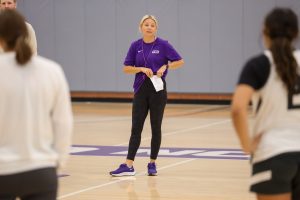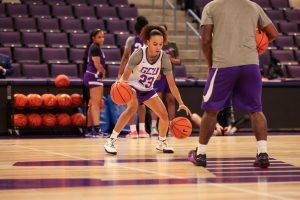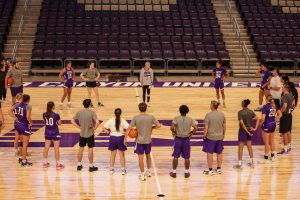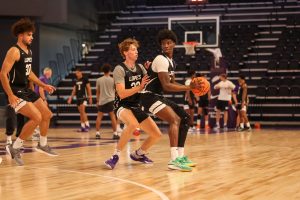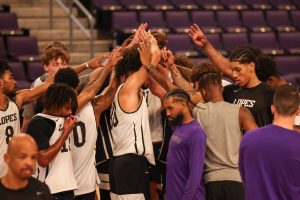- Slug: Sports-GCU MBB/WBB On Rise, 3,245 words.
- 5 photos available.
By Jonah Krell
Cronkite News
PHOENIX – Long before Jamie Boggs rose to become Grand Canyon University’s Vice President of Athletics, she was still roaming campus — but as a student.
This was back in the mid-1990s, when GCU, said Boggs, was “a modest campus, but still (had) a very warm feel.” Growing up a few miles away from the school, she took piano and singing lessons at the College of Arts and Media while still in high school, along with an English summer school class after graduation.
Boggs eventually left the Valley to study psychology at the University of San Diego and then law at the University of Arizona. But each time she returned home, the GCU campus had expanded even more.
“I remember asking my parents, ‘What is that?’” Boggs said. “They’re like, ‘That’s Grand Canyon.’ But back then I only knew it, when I grew up here, as a place that was good for music. And that was really it.
“I don’t know how much it was known. I only remember driving by it.”
At times people confused the school for being located in the actual Grand Canyon. But now GCU’s sprawling West Valley campus isn’t the only thing that can’t be overlooked. GCU has found its footing not with music, but with basketball.
“GCU is a school of choice,” said Molly Miller, the Antelopes’ women’s basketball coach. “I think when you’re talking about athletics and how much support it gets — honestly it can be a window to the university. We want to take that with pride and know that we can help propel some of the buzz around Grand Canyon and the Lopes.”
Since making the leap to NCAA Division I in 2013, both the men’s and women’s basketball programs have made similarly gradual strides to reach an ultimate winning expectation. Miller and men’s basketball coach Bryce Drew were both hired before the 2020 season and have nearly identical records — Miller sits at 63-27, and Drew is just ahead at 66-27.
Drew — the former Valparaiso and Vanderbilt head coach — has had immediate success, leading the Lopes to their first NCAA tournament appearance in 2021 and reaching the Big Dance again last season. Both years resulted in first-round exits.
Since Miller took over, the GCU women’s team hasn’t reached the same heights but has been close, advancing to the Western Athletic Conference Tournament final in her first two seasons. Last year, GCU was knocked out of the WAC semifinals as a No. 3 seed.
“We’re close, but it’s not good enough,” Miller said. “I think in our eyes and our coaching staff’s eyes and our players’ eyes, we’ve got the goal of going and winning a regular-season championship, and then putting our best foot forward and winning a WAC conference championship.
“We wouldn’t want to be anywhere else where those goals weren’t expected. This school breeds success from all the sports teams, and we want to be a part of that.”
As a whole, Grand Canyon has won 57 WAC championships since turning Div. I and has been awarded the WAC Commissioner’s Cup recognizing overall conference success for three straight years.
But for Boggs, this is just the starting point. In terms of setting goals within the athletic department, she doesn’t compare GCU to other schools. Instead, her focus maintains on keeping pace with the overall university’s direction, which has in turn set a lofty bar.
“You might think that maybe if I were somewhere else I’d say, ‘Hey, this is awesome how far we’ve come,’” Boggs said. “But because of what GCU is, in my mind (it’s), ‘Wow, we’re finally getting started.’ For what the university has done, to grow as quickly as it has, to me I equate that to within 10 years of going to the Final Four.”
Rising from a parking lot
Before Grand Canyon could even think about reaching the sky’s limit, it had to find a way out of a canyon-sized hole. The school switched to a for-profit model in 2004 as it was nearing bankruptcy, down $20 million in debt. In July 2008, GCU hired University President Brian Mueller, who Boggs calls “the greatest mind in higher education.”
Mueller’s vision was to build a hybrid learning model offering a mix of on-campus and online education. The online revenue soon exploded, and now more than 92,000 students are studying online at GCU. With its for-profit stance and online success, GCU invested over $1.7 billion back into the university over a 13-year span, building new dorms, facilities and a 7,000-seat GCU Arena.
Mueller’s efforts set off a domino effect of growth. In 2009, Grand Canyon had less than 1,000 students on campus. In August, it announced an expected record enrollment of 11,000 students to bring its on-campus total to roughly 25,800.
Once Mueller began putting his plan into action, it was time to build up the athletics programs. He sought help from one of the architects of Valley sports, Jerry Colangelo, who bought into Mueller’s vision. Colangelo made it a “personal agenda item” to turn GCU into a Div. I school, and three months later, he did that.
“I used to go over to Grand Canyon and watch the NAIA team, the Division II team basketball-wise, win a couple national championships,” Colangelo said. “There were 1,000 students on the campus, (it was) kind of a dusty, dirty place with Quonset huts for some buildings and the gym.
“But this is the American dream. You think about what it could be, not what it is. And Brian Mueller had that dream. He wanted to build a hybrid. He wanted to be able to pay for building out a campus, and he did that through online revenue. Pretty good story because they get zero help from the government.”
In 2018, GCU completed a transaction to return to its nonprofit status, with Mueller saying the school had reached a “solid footing financially.” It’s the classic rags-to-riches tale, one that Boggs says “defied the industry.”
Purple reign
With the university foundation in place, the 2013 renaissance of GCU men’s basketball started with the hiring of Dan Majerle, the former Phoenix Sun. Colangelo recommended his 1988 first-round pick for GCU’s head coaching job.
“Majerle was a really good coach when he was there,” said Richard Obert, who has covered GCU for The Arizona Republic since Majerle’s hiring. “He got the most out of his players. He was tough, rough. He wore his emotions on his sleeve.”
Majerle coached the Lopes for seven seasons and finished with an overall record of 136-89, reaching the WAC Tournament final in the program’s first two years of Div. I eligibility.
The groundwork Majerle laid was simultaneously buoyed by student support. The Lopes’ student section — known as the Havocs — was formed as the school neared its Div. I transition, with Mueller calling on student leaders to create game entertainment. Now, it is regarded as one of the best student sections in college basketball.
“They call it the purple party,” Obert said. “It’s a great environment. I’ve heard coaches call it the best college basketball environment in the country, even Rick Pitino when he was at Louisville, and he brought one of his better teams here.”
After four-straight 20-plus win seasons, Majerle’s Lopes ran out of steam in the 2019-20 season and finished with a subpar 13-17 record. GCU then made the coaching change to Drew, who has used “a totally different approach” than Majerle, according to Obert.
“He doesn’t wear his emotions, he kind of keeps it under his vest,” Obert said. “He gets the most out of his players too in a different way. They’re both different styles of coaching and reaching the athlete, and I think Drew has done an amazing job right now to build it up to get it to another level.”
Sharpening iron
Meanwhile, Miller was tasked with taking over a less-than-stellar GCU program since moving to Div. I. From the 2013-14 season to 2019-20, the Lopes had a combined 101-98 record spanning across two different coaching tenures. But mediocrity quickly flipped to winning under Miller, who strived to match the men’s team’s production.
“Bryce (Drew) and I got the job at the exact same time during COVID in 2020,” Miller said. “So now it’s like, we’ve seen their success and success breeds success. They say iron sharpens iron, so we all want to put our best foot forward for this university because it’s a great one. And I think because it’s becoming a school of choice, it’s enhanced our ability to recruit as well.”
The former Drury head coach has catapulted the winning momentum into luring eight newcomers from the transfer portal this season and starting off the campaign with a 2-0 record.
Since arriving at GCU, Miller’s teams have played with a scrappy, high-octane identity, as the Lopes have ranked inside the top five nationally in steals in each of her three seasons.
Trinity San Antonio, a transfer guard from California Baptist, was attracted to GCU because of Miller’s personality, which mirrors the Lopes’ play on the court.
“(Miller’s) energy – I played against her for two years,” San Antonio said. “Whenever we played against her I would just hear her yelling on the sideline, but she’s always happy and inviting and she has this spirit about her that you want to be about. So I think that’s really what prompted me to come here.”
San Antonio says that the coaching staff’s emphasis on intensity holds her to a higher standard on and off the court, and she appreciates Miller’s ability to push her players.
“You want a coach who’s passionate and can fire you up but is also fiery as well,” San Antonio said. “Because I don’t want to feel as if my fire is being diminished. I want to feel as if my fire is being fueled by the person that’s behind my back.”
As Miller has established a culture of spunk and spirit, Drew has molded a culture of family and faith. This has united a squad — which has also started out 2-0 on the 2023 season — featuring nine newcomers, seven of them transfers.
“Since the day I committed, it was a family,” said Duke Brennan, a transfer forward from Arizona State. “The coaching staff’s a family, they believe in you. I think GCU really finds a great group of guys from the transfer portal to come in and accept the family aspect, because nowadays, you can get these dudes to come in and they don’t accept the family aspect of it, and it doesn’t mesh with the team well.
“But they found an amazing group of guys to come in here and everyone bought in. Everyone’s buying in.”
The heartbeat of the hoops family is sixth-year redshirt forward Gabe McGlothan, the Lopes’ second-leading scorer last season who was named to the preseason All-WAC team ahead of this year. McGlothan has leaned on his strong faith identity to be a leader for the team.
“I’m a Christ follower, I’m a servant,” McGlothan said. “So it’s been cool to see my role translate with these guys. I don’t want to be the ceiling for these guys, I want to be the floor and help push them up. So I think they’ve really helped me guide me in that and know my faith and know who I am and what my purpose is, and it’s more than just basketball.
“It’s why leadership is huge to me. That’s why this is like a family because we all have each other’s backs and we’re not afraid to be there for each other, because they were there for me and they’ve helped me grow up.”
McGlothan’s words echo Boggs, who says the basketball programs’ mindsets are representative of the entire school, which is a Christian university. One of the keys to an athletic program’s success is having its values be in line with the overall university. Without this link, there can be a “disconnect” for the athlete, resulting in past mistakes from which Boggs has since learned. Now, the two teams are in sync with GCU’s overall mission.
“It’s funny because for having 26,000 students, everyone will tell you the thing they love most about here is its community,” Boggs said. “And that’s hard in a school that has as many students as we do, but everyone will tell you the same thing. So that family-feel … that really strong servant-leader, Christ-centered feel — that’s the feel of the university.”
Eye-popping numbers
In addition to these burgeoning cultures, Grand Canyon’s leadership team has made basketball a financial priority. Without a football program, the university pumps a hefty amount of its resources into basketball. For comparison, according to the U.S Department of Education’s most recent data from 2021, the Lopes’ combined basketball operating expenses were nearly $350,000 more than ASU, a Pac-12 Conference school with over triple the amount of on-campus enrollment.
Meanwhile, the GCU men’s team’s revenue ($6,786,395) was nearly $3 million less than the Sun Devils’ men’s counterpart ($9,458,824).
The numbers are eye-opening. For Boggs, it makes her think back to the near $2 billion investment from Mueller into the overall university, a privilege that distinguishes the Lopes from the rest of the mid-major schools in the WAC.
“I consider us a high-major program with the support we receive from our university, with the support we get from this community, with our students,” Boggs said. “Everything we have — the intangible resources like being in the city of Phoenix, just this campus. We’re a high-major institution with high-major support. So our goals are to be nationally competitive. I like where we’re starting, but we’re just starting.”
For context, the 2021 data was from Drew’s first year when the Lopes made the NCAA tournament. Boggs says it’s hard to put a dollar value on the brand and awareness amassed from reaching the Big Dance, but recognizes that “the jump was huge.” At the same time, GCU has left more money on the table with its struggles to advance.
“The reason why they like basketball so much is because they feel — and why they don’t have a football program — is because they feel they can make more money through basketball,” Obert said. “And you do that by winning NCAA tournament games because the ratings are so high for those games. The farther, the deeper you go in these tournaments, the more and more money comes to that school that wins. So that’s important for Grand Canyon — it’s important for them to get over that hurdle now and start winning some games in the tournament.”
This season, the GCU men’s team has five nationally-televised games on its schedule with potentially more coming if it reaches postseason play. This number already ties a program-high from last season, which featured the WAC Tournament championship and the first-round tournament loss to Gonzaga.
The TV slate is only proof of the national noise GCU continues to make. One of those men’s matchups will be against national championship-runner up San Diego State at home on Dec. 5. While the women don’t have a nationally televised game this season, they already have their own top-tier contest against Oregon Thursday night.
While the media is starting to recognize the Lopes more, touted transfers — and even past successful head coaches like Drew and Miller — have already seen GCU’s potential and have now turned it into a destination place.
“One of the things that makes GCU so great is our fan base, is our campus, is the city of Phoenix,” Drew said. “We have found (that) we get high-level transfers that come from top-25 programs and from day one they love it here, just because our facilities are first class, (and) our fan base is one of the top in the country. So it’s really been an easier transition than what you would think for a lot of these guys.”
Boggs also points out the school’s glamorous facilities, with their dazzling charm being matched by the year-round Phoenix sunshine. But perhaps what makes Grand Canyon far more enticing than its shiny exterior is the focus on the individual, and what they can ultimately contribute towards.
“It’s really about, look — we have everything it takes not just for a team to be successful but for a student-athlete individually to be successful,” Boggs said. “But the other thing is a lot of student-athletes do want a place where they feel a part of a community, they want to do something bigger than themselves. And for a lot of student-athletes, they are drawn to our mission. They’re drawn to the fact that we are involved in the community.
“My point is that we hit a lot of boxes when it comes to what recruits are looking for. But our ability to win and win at the national level is one of them.”
And while each athlete has their own priorities when choosing a school, it doesn’t hurt to be able to contribute to a winning team, which is what GCU basketball is starting to accomplish on both the women and men’s levels.
Just ask Brennan, a bench piece with the Sun Devils last season, who tallied his first career double-double (career-high tying 12 points, career-high 10 rebounds) as a starter in the Lopes’ season-opening win against Southeast Missouri State on Nov. 6.
Or ask San Antonio, who averaged just 2.5 assists per game across two seasons with the Lancers, and is now flirting with a triple-double average over her first two games as a Lope. In GCU’s season opener against Saint Mary’s last week, she scurried into the frontcourt and shoveled the assist on junior guard Naudia Evans’ buzzer-beating 3-pointer.
The new faces have already taken advantage of their new roles.
“(The transfers) feel that they might have a better opportunity of getting more playing time,” Obert said. “Being that guy, being more of a factor.”
So now the stage is set. Both teams reloaded their rosters and have aspirations of making the tournament. The outside expectations are clear and present, as both squads were picked to win the WAC in their respective preseason coaches polls.
Obert thinks that pending injuries, this year’s men’s team could be the program’s best.
“I think they could win a tournament game,” he said.
That will be the ultimate question. Both basketball programs have taken massive strides over their decade-long Division I tenures to reach this point, but the proverbial glass ceiling has yet to be shattered.
But Boggs turns the question on its head. The former musically-inclined student, working at her old stomping grounds, sits up in her black-cushioned office chair and belts her chorus one last time, with gusto.
“If you look at top-ranked programs, we’ve fared very well against them over the past since we’ve been Division I,” Boggs said. “So my point being is we just have to accept that this is who we are. We are a nationally competitive program. We have everything it takes to win and to be successful. We have both tangible and intangible resources that other universities don’t have. And we have this incredible culture that allows us to really go to that next level. These are really unique things that will allow us to move along in the same trajectory as the university.
“You asked for challenges but I don’t really see challenges. I see opportunities. And I think that’s how this university has always operated.”
For more stories from Cronkite News, visit cronkitenews.azpbs.org.
